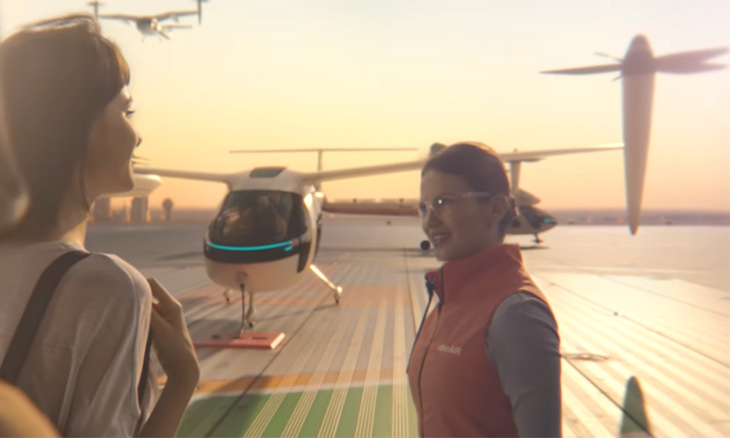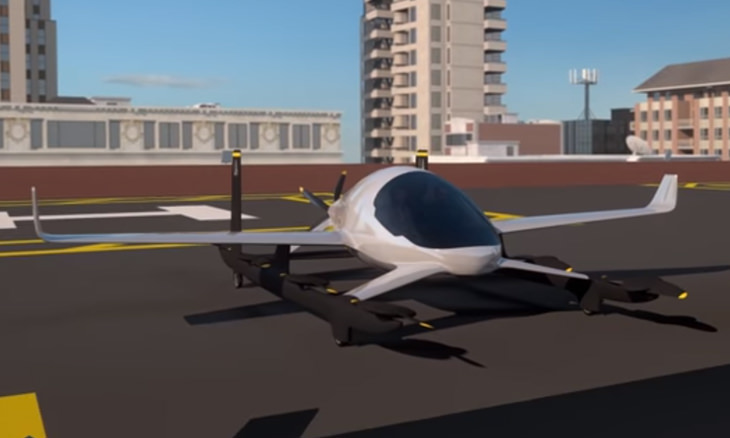
Visionaries around the world are predicting a zero-emissions, autonomous future for transportation, and the innovations that seem to pop up every single day are consistently pushing the envelope of what’s technologically possible. Many of them think that we will be taking to the skies with much more frequency in the near future, as is evidenced by the three amazing projects you’re about to see:
1. Uber and NASA team up on flying car project
Los Angeles is the most congested city in the world, with commuters spending some 104 hours stuck in traffic jams on average each year, so perhaps it’s no surprise that the likes of Elon Musk and Uber are focusing their attention on the city.
Uber recently announced that it intends to make a flying taxi service operational in the city within the next two years, and has teamed up with NASA in order to develop a dedicated air traffic control system for the new service.
The service, which is called Elevate, will use vertical take-off and landing flying cars that might even be able to fly between destinations autonomously. The biggest challenge that Uber faces is getting the necessary infrastructure in place for the system to work, but they’re definitely not messing around – a former NASA engineer is already hard at work designing the system.

NASA is said to be very keen for an un-crewed traffic management system to take hold in major American cities, and Uber Elevate is currently aiming at bringing its flying taxi service to Dallas-Fort Worth, Dubai and Los Angeles.
Uber is currently in talks with various potential vehicle manufacturing partners about the performance specifications required to make the Elevate project successful, however, it remains to be seen whether there’ll be flying taxis in the aforementioned two cities in the next two years.
2. Elon Musk wants to build city-to-city rockets
Imaging having to fly across the Atlantic Ocean for an urgent meeting that same morning. It’s a feat that’s impossible right now, but one day you might be strapping yourself inside a 350-foot rocket with 100 other passengers and being on your way from New York to London at 17,000 mph.
The rocket design, which is nicknamed BFR (for Big F*****g Rocket), is the brainchild of billionaire tech genius Elon Musk. It aims to be able to transport passengers between New York City and London in a mere 29 minutes. That’s 10 times the speed that the supersonic Concorde jet used to manage!
Musk announced his plan, which will become the fastest commercial mode of transit ever created if it is realized, during a keynote speech that also detailed his latest concept for colonizing Mars. It employs ballistic physics, and will be able to transport passengers between New York and Shanghai in 39 minutes, or Los Angeles and Tokyo in 32 minutes.

He also claimed that BFR could begin flying in five years’ time, and the cost of a ride to anywhere in the world in under an hour would be “about the same as full-fare economy in an [conventional] aircraft.”
Various experts have expressed their doubts over whether the project can be realized in just five years, citing the many practical problems that need to be overcome. Nevertheless, people bet against Elon Musk doing what he says he’s going to do at their peril.
3. Aviation giant Boeing embraces autonomous technology
Boeing recently acquired Aurora Flight Services, underlining its commitment to incorporating autonomous technology into future aircraft designs. It has also invested in another company named Near Earth Autonomy, which focuses on technologies that enable reliable autonomous flight.
It’s Boeing’s newly set-up Horizon X Ventures division that’s making the investments and acquisitions in the autonomous technology sector, and the division is working closely with Near Earth on various applications for autonomous technology, such as flying taxis.
Near Earth Autonomy was founded by Sanjiv Singh, Marcel Bergerman, Lyle Chamberlain and Sebastian Scherer, who collectively have 30 years’ worth of experience with autonomous systems designed for both land and air vehicles.

Back in 2010, the men teamed up with the US Army to develop full-scale autonomous helicopter flights, as well as an autonomous aerial cargo delivery platform for delivering supplies to US Marines.
The latest moves by Boeing are further evidence of the increasing popularity of flying taxis in the aerospace and aviation industries, because it’s expected that they will change how people navigate through cities and traffic. The likes of the city of Dubai, Airbus and Lilium are all currently working on flying taxi projects. Will conventional vehicles that require a driver soon become a thing of the past?